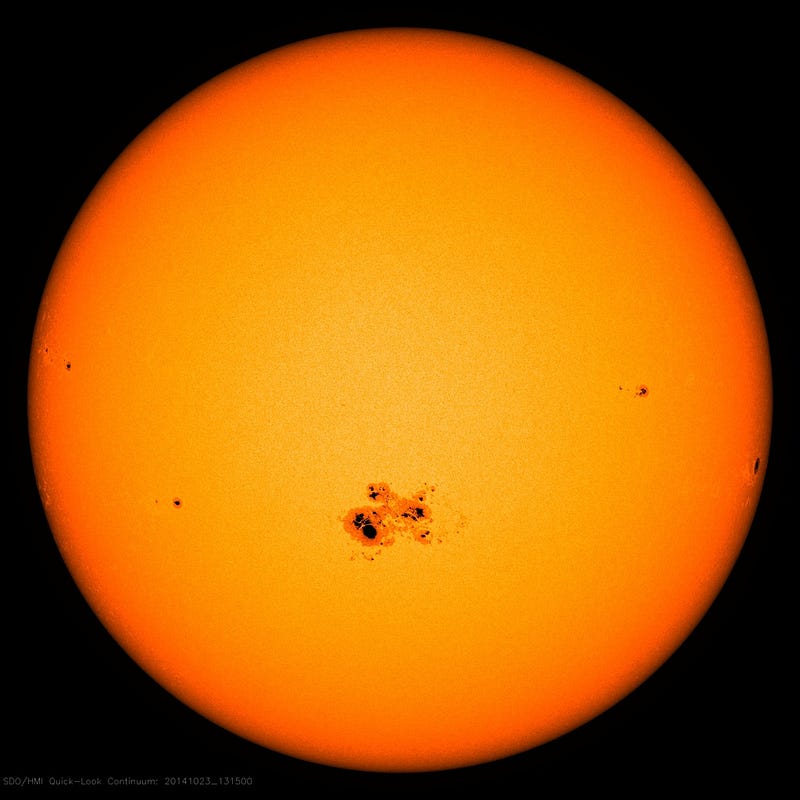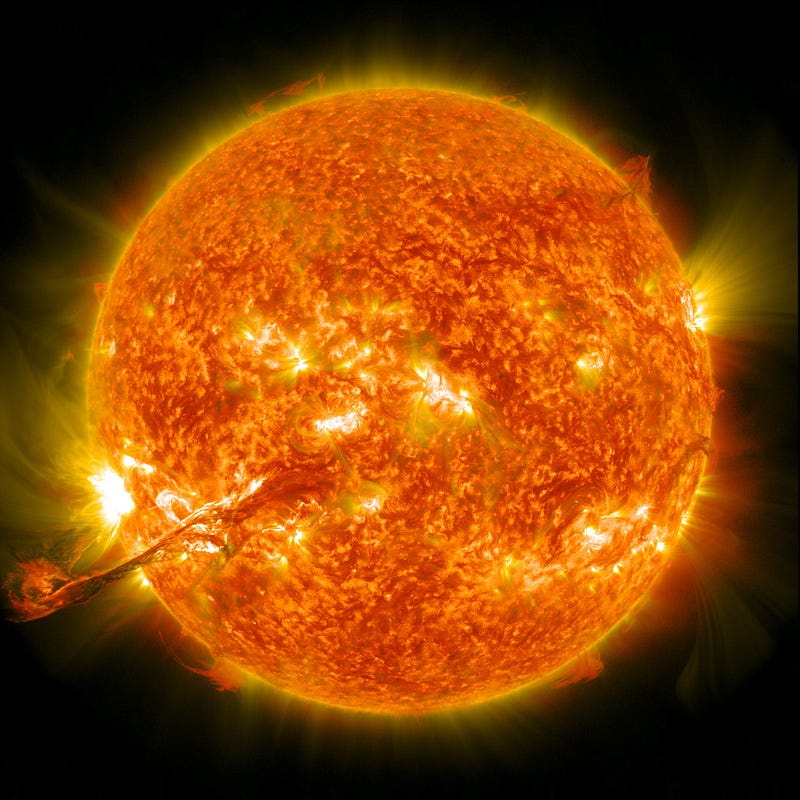Exploring the Mysteries of Sunspots: A Deep Dive into Solar Science
Written on
Chapter 1: Understanding Sunspots
If you have ever gazed at the Sun through a solar telescope or glimpsed an image captured by a space observatory, you might have noticed the dark patches dotting its surface. But what are these shadowy marks, and what insights do they provide about the Sun's inner workings? The answers may surprise you.

This image illustrates sunspots on the Sun's surface, captured by NASA’s Solar Dynamics Observatory in October 2014. Credit: NASA Goddard Spaceflight Center.
The dark areas visible on the Sun's surface are referred to as sunspots. Although they appear dark, they emit their own light. This phenomenon occurs because they are significantly cooler than the surrounding solar surface, making them look black as the brighter regions overshadow them.
Sunspots vary greatly in size and shape. The largest known cluster of sunspots was discovered in 1947 and was roughly equivalent to 141 Earths in diameter. The duration for which a sunspot remains visible can also differ widely; some last only a few hours, while others can persist for several months.
To observe sunspots without a telescope or binoculars, they must be at least twice the size of Earth. It's crucial to use the correct equipment to protect your eyes while observing the Sun. Solar filter glasses are inexpensive and readily available for solar viewing. If you plan to use a telescope or binoculars, ensure you have a solar filter specifically designed for your device. Always inspect your solar glasses and filters for any defects before use. Remember that while sunglasses may help with bright daylight, they do not offer sufficient protection for solar observation. Only specialized solar filter glasses ensure proper safety when looking at the Sun.

This image shows two individuals observing the total solar eclipse in 2017 while wearing solar filter glasses. Credit: Adam Smith on Unsplash.
Sunspots are not mere surface blemishes; they are indicative of active regions within the Sun’s potent magnetic field. These areas arise from the dynamic movement of gases within the Sun, which leads to the twisting and intertwining of its magnetic fields. Some magnetic fields extend to the surface, creating cooler regions that manifest as sunspots. Typically, sunspots appear in pairs, each representing either the north or south pole of the magnetic field. The magnetic field lines connecting these sunspots arch above the solar surface.
The movement of the Sun's magnetic fields generates more than just sunspots; it is the driving force behind all solar activity. Other forms of solar phenomena include solar flares, solar prominences, coronal mass ejections, high-velocity solar winds, and solar energetic particles. Notably, solar flares and prominences are closely linked to the magnetic activity associated with sunspots.

This image captures a coronal mass ejection from the Sun, recorded on August 31, 2012. Credit: NASA on Unsplash.
A solar flare is a substantial burst of radiation originating from the Sun’s surface, representing one of the most explosive occurrences in our solar system. These flares can happen multiple times a day, though sometimes they may only occur a few times monthly. The energy from these events can travel vast distances, with some ejecting material up to 240,000 km into space.
In contrast, a solar prominence may not always explode into space. Instead, it is a substantial loop of plasma that follows the magnetic field lines connecting two sunspots. A typical solar prominence measures around 100,000 km, roughly ten times the diameter of Earth. While many solar prominences flow along the tangled magnetic lines of sunspots, some can become unstable and burst outward, releasing plasma similarly to solar flares.
Interestingly, solar activity is not constant over time. Astronomers have tracked the Sun's average activity and discovered a cyclical pattern known as the solar cycle. This cycle occurs as the Sun’s magnetic field completely reverses approximately every 11 years, switching its magnetic poles. It then takes another 11 years for the poles to revert to their original positions.

These ultraviolet images of the Sun depict its activity throughout the 11-year solar cycle, highlighting peak activity in the center compared to minimal activity at the cycle's edges. Credit: ESA/NASA/SOHO.
During the decade required for the Sun’s magnetic poles to flip, the level of solar activity fluctuates. At the midpoint of the solar cycle, activity peaks, evidenced by an increase in sunspots and other solar phenomena. Conversely, at the beginning and end of the cycle, solar activity significantly diminishes, resulting in fewer sunspots and solar flares.
We are currently experiencing what experts refer to as Solar Cycle 25. This cycle commenced in December 2019, with expectations for solar activity to peak in 2025. It typically takes several months after peaks or lows in solar activity before scientists can gather sufficient data to confirm these events. As solar activity rises in the coming years, we can anticipate an increase in visible sunspots on the Sun’s surface. Remember to follow safety precautions and never observe the Sun without appropriate solar filters.
The first video titled "What Are Sunspots?" provides an insightful overview of these intriguing solar phenomena. It explains how sunspots form and their relationship with solar activity.
The second video titled "Sun spots" delves deeper into the characteristics of sunspots and their impact on solar dynamics.